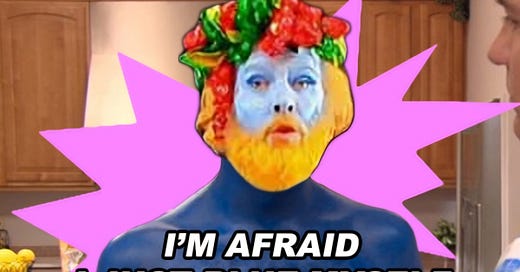Typically, I refrain from torturing myself with the opening ceremony of the Olympic games since it is not designed to entertain someone like me. I really only watch any of the events because my wife puts it on or something is shared on Boomerbook or X-Twitter. The most direct interaction I have with the Olympics is googling to confirm that America has won the most medals, proving that the USA is the greatest nation on planet earth.
Edit: 2 August 2024
What in the California is this?! I am so embarrassed for the greatest nation in the world…
With that said, the hell that is social media exploded with outrage over a half-naked Smurf flopping on a table with a mitre-bearing woman manning a DJ station in the background. Well, color me intrigued. I guess I am compelled to force my eyeballs to consume this French horror that seemingly erupted from H. P. Lovecraft’s brain.
On one side of this kerfuffle, many were bemoaning the Olympic committee and France would allow a performance to mock Christianity openly, specifically the Last Supper (da Vinci). The opposition retorted that those with ruffled feathers should get educated and realize this is an interpretive celebration of Dionysus, specifically the Feast of the Gods (van Bijlert). So, which group of terminally online, perpetually angered, pitchfork-toting troglodytes is, in fact, correct?
Well, how about this, both groups are right and wrong simultaneously. Why must I choose between mocking da Vinci with poorly dressed homunculi or dishonoring Dionysius with a pot bellied Smurf? I will detail why I believe both images were clearly in the mind of Thomas Jolly,—regardless of how much he doth protest—and explain why everyone needs to sit down, have a bourbon, and chill. Ultimately, the greatest insult was not against the Last Supper, but Dionysus and the viewers.
Desecration of the Lord’s Deipnon, the Last Supper?
This one scene from the opening ceremony elicited quite the negative response from numerous prominent Christian leaders—Catholic and protestant. The Conference of French bishops claimed, “This ceremony has unfortunately included scenes of derision and mockery of Christianity, which we very deeply deplore.” Archbishop Hartmayer of Atlanta remarked,
Leonardo da Vinci’s famous painting of the Last Supper was recreated in which a female disc jockey depicting Jesus, along with dancers and drag queens, representing the Apostles, struck poses along a long table mimicking da Vinci’s painting. This was utterly reprehensible and grossly offensive to all people of goodwill.
A plethora of social media accounts included side-by-side comparisons of the two images:
At first glance, the resemblance is uncanny, especially when considering how common this layout is for depicting the final meal between Christ and his disciples—all or most on one side of the table:
If one wishes to deny that da Vinci or any other painter—be they Italian, Spanish, or French—played a role in staging this performance because Greco-Roman meals are depicted similarly, there are other aspects that illustrate potential Christian imagery and dependence.
First, notice the lady’s garments in the front and center. The headdress—hat, crown, whatever they want to call the cap sitting atop her head—resembles that of a bishop’s mitre:
Though a bit rounder, the resemblance is not happenstance. Take also the stars radiating from said mitre. It could be reminiscent of either a traditional halo in iconography or stars that are commonly associated with Mary, Queen of Heaven. The two characteristics are essentially identical in significance, so pinpointing an exact influence is unnecessary. The pedestrian meaning is apparent: it is a marker of significance; this person is to be noticed. More sacrilegiously, a marker of sainthood and holiness, a status this individual has obviously not achieved.

Our character of significance, centered at the table, is also vested in blue, which is by no means a coincidence considering the importance of colors in Christian art and iconography. It is a common detail in iconography to depict Jesus wearing a blue outer garment with a red one underneath to represent his humanity wrapped in divinity. And so, Mary, in contrast, is commonly colored with red outer garments and blue beneath to represent her human form housing the divine, i.e., Jesus—so the title Theotokos:
This is certainly not a hard-and-fast rule since Mary is routinely depicted donning predominantly blue, which for this particular analysis is key:
If you believe it is mere coincidence that
the scene is framed exceedingly similarly to the Last Supper,—not only da Vinci’s but others
The headdress resembles a bishop’s mitre
The stars mimic a halo or those that surround Mary’s head
The dress is blue—common both for Jesus and Mary
that is your prerogative. But, in theater and art, the devil is in the details, and it would seem rather unbelievable that these features were not intentional. At what point does coincidence become intent?1
Perhaps my specialization has colored my opinion, which I am fine to admit. But, upon my first viewing, these are the aspects that stood out to me. Upon learning the Feast of the Gods was the purported inspiration, I raised an eyebrow because the resemblance is far less obvious—again, to my eye.
More damning for any contestation, though, our central protagonist wearing blue shared an image—now deleted—on her Instagram story, stating this was the Last Supper, “The New Gay Testament”:
No, this does not prove intent; it is no smoking gun. But, there is certainly no denial. France TV, too, declared the scene—again, in a now deleted tweet—to depict the Last Supper:
If your argument contains the idea that it was purely “MAGA” or conservatives or Christians freaking out over a mocking of the Last Supper, it appears that some within the production and the French media—at least one major outlet—were perfectly comfortable with a Last Supper interpretation.
Does this warrant outrage? Personally, no; I do not believe it does. Justifiable discontent should be directed toward our comically blue god, Dionysus.
The Mockery of Dionysus
There is no denying that after the scene at the tableau, Dionysus is served up on a silver platter. As the official X-Twitter account for the Olympics posted:
Let us first take Jolly at his word that this is meant to be a depiction solely of Dionysus and the pantheon, and the consumers are gathered together celebrating harmoniously.
Well, this is still problematic because the depiction of the character—Dionysus—is jarring, both in image and nature.
First, I challenge you to find a painting or illustration of Dionysus blueing himself.
The distinctive coloring of attic pottery is orange and black, so no other colors would show. But, how about those paintings that people claim are the inspiration for this depiction? These, too, lack this unique coloring.
After perusing these pieces, do you notice a blue Dionysus laying upon a platter? Aside from this nonsensical feature, our modern Dionysus also lacks his Thyrsus—a pine cone staff, commonly depicted with vines—nor does he have a cup, and the grapes and wine are not emphasized. When I saw this creature, I first thought of Dionysus because it was the only logical choice at first glance, but this depiction lacks his trademark features, and he is not accompanied by his notable cronies, the satyrs—more on their lecherous nature to come.
Additionally, if I am to be convinced the others at the table represent the pantheon, why do they lack all the key characteristics of these gods or goddesses? Not a single one even remotely resembles a Greek deity; they all lack a bird, an instrument, a helmet, an aegis, a weapon, a shield, anything and everything that would indicate that this is paying homage to the Greek pantheon. If I can show direct Christian parallels with the scene,—intentional or otherwise—but the only “recognisable” Greek god is Dionysus—whose caricature is honestly terrible—what am I to conclude? And, do not begin with the Olympic games are pagan in origin nonsense; you still have to try.
Far too many in the western world are completely ignorant of Greek culture and mythology—not to mention renaissance art—to realize that those reclining at table were meant to be representative of the pantheon; expecting someone to detect The Feast of the Gods is absolutely absurd. In fact, one blowhard I found on X-Twitter posted that people need to get educated and realize our Jolly blue friend is Zeus—of course he has since deleted the tweet, and I failed to capture it. For that matter, Zeus would have been a better selection. Sure, he does not at all embody the message the Olympics or Jolly wished to convey, but just wait. Dionysus is just as horrible.
--
Alright. How about we forget about this poor interpretation of Dionysus because this is ultimately just my subjective opinion. I personally find this offensive because it lacks any true semblance to the Greek god, but that does not negate Jolly’s “artistic” vision.
But, I will mock the utterly foolish statement that choosing Dionysus was to highlight “the absurdity of violence between human beings”—that we should focus on love and togetherness rather than on strife. In turn, if this is not the interpretation of the tweet by the official Olympics account, Jolly’s apology/statement about unity and inclusion is hollow.
Now, for all those chastising dissenters for not being educated, have you not read Euripides’ Bacchae? The Greek tragedy tells the story of Pentheus,—king of Thebes—who attempts to ban the worship of Dionysus and delegitimizes the god because of his newness, to which Dionysus responds by causing a gaggle of women—including Pentheus’ mother and aunts—to fall into a fit of Bacchic rage, resulting in them tearing Pentheus apart, limb from limb:
With all the Bacchic horde attacked: there was a cry,
One sound from all together; Pentheus, while he breathed,
Groaned, but the others cheered. A fore-arm one had got,
The feet another, with the shoes; his ribs were stripped
Piece-meal; those women, every one, with bloody hands
Joined in a ball-game, using bits of Pentheus’ flesh.
The body lies in different places, part below
Sharp rocks and part in thickets deep in undergrowth,
Not easy to discover, but the wretched head
His mother chanced on and she took it in her hands
And fixed it on her thyrsus, thinking it to be
A mountain lion’s... (lines 1131–41)
Indeed. Doesn’t this just screech of non-violence, acceptance, and inclusion?
As for the Dionysia/Bacchanalia, it was known for drunken frivolity and general degeneracy. And let us not forget the satyrs, who were known to rape nymphs and women. Their depictions are rather unseemly in pottery—I chose a mild example:
If we concede there is not any mockery of the Last Supper, we still have to reconcile the fact that this was a terrible depiction of Dionysus. Additionally, if Dionysus is truly what you want as the focal point for non-violence and inclusion, he really is a poor figure to showcase considering how murderous and deranged he could be—having Pentheus’ mother play bball with her son’s own head is certainly a delightful image. Lastly, although they are not represented on stage, the satyrs—who are present in the purported inspiration—are degenerate perverts and rapists.
The gods were fickle, mercurial,—heh—and they ultimately represented some of the most deplorable features of humanity. They squabbled, they fought, they raped, and they deceived. They were selfish, jealous, vindictive, and vain. I love Greek culture, language, and mythology, but let us not delude ourselves into believing we should strive to be imitators of Dionysus or any other Greek deity, nor should we believe their views are congruent with our ethics and morals. Afterall, go and read Plato's Symposium; discover what love is and how it relates to pederasty.
I’ll concede no Christian mockery, but I want to see the justification for using Dionysus to represent... What was it again? Oh, right, “the absurdity of violence between human beings.” Think what you will about the performance, but Dionysus is a garbage candidate for the message Jolly wished to convey to the world. Those angry about the misrepresentation of the Last Supper should certainly be aghast at how this performance utterly insulted Greek mythology, while attempting to force a message founded upon a contrived, distorted caricature of Dionysus.
Conclusion
Both sides are frustratingly obstinate, and they are incapable of seeing any legitimacy in their opponents’ perspective. I fall in the camp that believes there is certainly Christian influence in this production. Where I differ, though, is being offended. The ultimate focus was on Dionysus, but there is a blending of the two images. As I have stated previously, my contention lies in the poor presentation of Greek mythology.
That said, Christians have jumped the shark. I can agree that there are resonances with the Last Supper in this performance, and I understand why someone could find it problematic. But, as for this talk concerning a golden calf from Exodus and a pale horse straight out of Revelation, let’s pump the brakes. Hard. That statue was preexistent, and you are reading Revelation wrong—it is Jewish apocalyptic literature. Please, stop interpreting this text and assuming the world is about to end or that it directly relates to our dire times. That's not the purpose of the book. For a concise, cogent explanation, check out Bauckham's commentary.
And, if you're feeling saucy, read John Collins’ work on apocalyptic literature; it is an amazing introduction to the genre.
In short, Christians should stop having a seizure over a potential depiction mocking the Last Supper simply because it is a common template in our culture. BuzzFeed even did an article (2013) on the top 50 da Vinci parodies.
On the other hand, outright denying any potential influence of the Last Supper and, in turn, mocking Christians for being offended is rather ridiculous. If our director did not intend to lampoon the Last Supper,—I refuse to comment on intent since that is unknown—he would have to be incredibly obtuse not to realize that it could easily be interpreted that way, and that goes for anyone lambasting someone who notices connections. Let's take a poll: how many of you knew of da Vinci's Last Supper? How many knew about the Feast of the Gods? Better, how often do you see the latter referenced in the cultural zeitgeist? Popularity proves nothing, but it is an indicator of how people will perceive the imagery.
Part of the problem—at least based on what I have been able to find—Jolly disclosed his inspiration after the performance and backlash. If the Last Supper had been influential, we probably will never know. The blow back was so severe, there will only be denial by all parties. Not to mention, the deletion of posts adds to the problem since one could easily accuse the Olympics of circling the wagons. Again, fine if the honest truth is that the Feast of the Gods is the sole muse, but my problem still stands: why did you do Dionysus dirty?
Edit: 4 August 2024
Since writing the above paragraph, It’sAGundam made a video on this topic, and provided a juicy headline that contradicts Thomas Jolly’s defense:
The article states,
“For the ‘Festivities’ segment, Thomas Jolly took inspiration from Leonardo da Vinci’s famous painting to create the setting,” producers said in the statement. “Clearly, there was never an intention to show disrespect towards any religious group or belief … [Jolly] is not the first artist to make a reference to what is a world-famous work of art. From Andy Warhol to ‘The Simpsons,’ many have done it before him.”
So, which is it? Methinks now more than ever Jolly doth protest too much.
Which leads to a new critique that I decided to add now that the dust is beginning to settle. People like Dan McClellan have pretentiously declared you need to be educated and be more culturally aware before commenting on this topic:
Now, if you can overcome his out of breath rambling, he insults your intelligence and cultural knowledge. But, I must ask people like Dan, did you actually think of the Feast of the Gods prior to seeing Jolly’s statement? I refuse to comb through Dan’s posts to see because he vomits out insults and vapid takes ad nauseam all day—publishing on TikTok rather than JBL—but I highly doubt he argued this until he read the official statement from the director.
Regardless of this, the parallels he notes are far less convincing than those that resonate with Christian imagery. Again, I am perfectly comfortable being wrong about this, but the producers’ statement has emboldened me to believe Jolly’s defense is a definite CYA. To repeat myself, I do not believe it is a total lie; rather, I think both images were in mind.
Regardless of what was intended, Thomas Jolly failed. This performance will be remembered as the most divisive opening ceremony in recent memory. Even if Dionysus and the gods were truly the influence, it was just plain awful to watch, and it was a mockery of Greek culture. It in no way resembled the gods and goddesses of ancient Greece, and I personally find that offensive.
Most every response to this situation has been grotesque. Insults have been hurled, accusations made, discord sowed, all of which has happened to what end? A lesson to be learned from this disaster should be, sit, contemplate, have a drink, and then maybe respond. Everyone, seemingly, assumed the worst, which just exacerbated the animosity towards the perceived “enemy,” which ultimately benefits no one.
Although this is not a typical post for me here seeing as it concerns a modern “issue,” Ι hope you found it enjoyable. If you wish to learn more about the New Testament and its world, would you kindly subscribe?






































